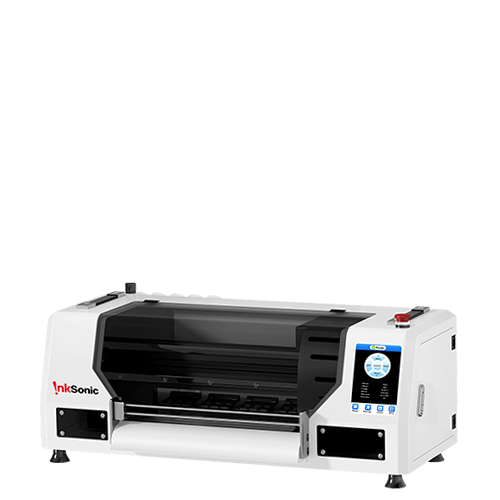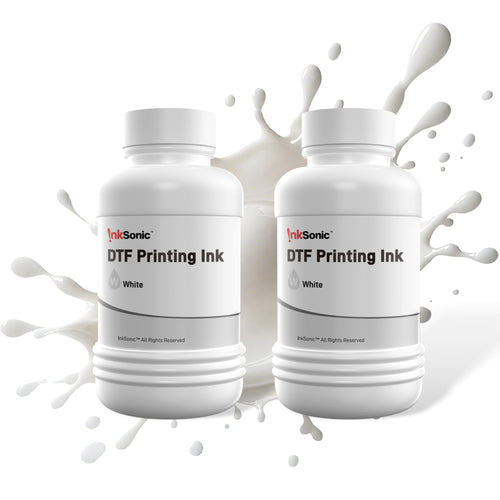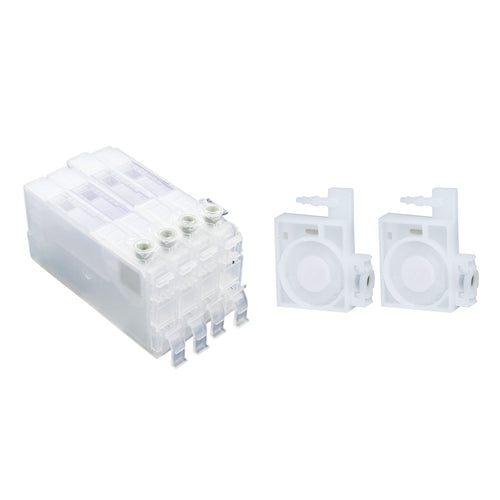1. Introduction
DTF (Direct-to-Film) printing is a smart way to transfer bright designs onto different fabrics and materials. Sometimes, printers have issues with white ink. It may not be dense enough, leading to poor print quality. If you are facing this problem, here are some causes and solutions.
2. DTF Printing Patterns When White Ink is Not Thick Enough

In DTF printing, insufficient white ink density can lead to:
Blurred or Unclear Designs: The base layer is uneven, making the design look blurry.
Faded Colors: Colors may appear dull or distorted without a proper white ink base.
Uneven Patterns: Thin ink causes blotchy or inconsistent prints.
Poor Transfer Quality: Inadequate ink prevents proper adhesion to the fabric.
Through-Color Issues: The fabric’s color may show through, affecting the print’s look.
3. Not Thick Enough: Issues and Solutions
3.1 Incorrect Print Software Settings

Incorrect DTF settings in the printing software can lead to issues. For example, a low concentration of white ink may cause weak ink flow or problems with.
Solution:
Check that the software is configured for printing. It should generally be at 100% concentration.
Check ink density and thickness, and use profiles specifically designed.
Adjust the DTF settings. You can change the print speed, resolution, or layer settings. This will help you achieve the desired effect.
3.2 Clogged DTF Print Head

A clogged DTF print head is one of the common causes of thick or uneven ink. The DTF print head applies ink to the transfer film. If the nozzles in the printer get blocked, the ink flow will be reduced.
Solution:
You can follow below steps do a printhead cleaning. But if the clog is serious, you may need to do a deeper cleaning or replace the DTF printhead.
Steps:
- Gradually extract 10ml of waste ink from the tube, clean the cleaning unit wiper, and check if the ink pad is worn or damaged and needs to be replaced.
- Gradually extract ink from the cartridge until it is fully filled with ink.
- Perform a program cleaning and then test the print.
For more deep-cleaning tips on print head clogs, please refer to our blog: Prevention and Solutions for Print Head Clogs.
3.3 DTF Print Head Vapor Lock

Air bubbles in the ink lines can disrupt ink flow, causing the ink is not thick enough or uneven. Air bubbles also cause pressure imbalances, leading to uneven ink distribution.
Solution:
Extract 10ml of waste ink from the tube in batches, clean the cleaning unit blade, and check/replace any worn ink pads.
Prime the ink cartridges until fully filled.
Run a cleaning cycle and test print. For more solutions on air in the ink lines, refer to our blog: How to Resolve and Prevent Printhead Air Clogs.
For more DTF printhead vapor lock, please explore our new blog: DTF Printing: How to Fix and Prevent Print Head Vapor Lock
3.4 Ink Circulation System Malfunctioning

If the printer's white ink circulation system isn't functioning properly, the white ink is not thick enough. This results in uneven or patchy coverage on the print surface.
Solution:
Inspect the circulation system for blockages or leaks. Or if it still can't work, please replace the white ink circulation system
Clean the system and replace any worn or damaged components, such as waste ink pumps, ink tubes, or ink cartridges.
3.5 Inactive White Ink Agitation

If the ink agitation system is not working properly, white ink may settle, causing the white ink is not thick enough or uneven.
Solution:
Turn off the machine and manually stir the ink tank with a small stick.
3.6 Ink Issues
3.6.1 Incompatible Ink
Sometimes the white ink used may not be compatible with the printer. If the ink's viscosity doesn’t meet the printer's needs or the DTF process, it can lead to poor print quality.
Solution:
Use ink specifically designed for DTF printing, and ensure it is compatible with your printer model.
Always check ink compatibility with the printer before purchasing.
3.6.2 Poor-Quality or Expired Ink
The quality of direct-to-film ink is critical in the printing process. Poor quality, expired, or improperly stored white ink can lead to uneven flow. This often results in weak or blotchy prints.
Solution:
Always use fresh, high-quality ink from trusted suppliers.
Look at the ink's expiration date. Make sure to store it as the manufacturer advises. Usually, that means a cool, dry spot, away from direct sunlight.
If you suspect the ink has expired or degraded, replace it with fresh ink for better print quality.
3.6.3 Ink Sedimentation
Over time, the pigment in ink can separate, especially if the ink has not been used for a long period. This causes uneven ink flow and blotchy white areas on prints.
Solution:
Stir the ink tank manually with a clean stick to prevent pigment separation.
Our ink tanks have a built-in agitation pump. This pump helps stop pigment from settling. If you keep having sedimentation issues, try our ink tank. It has a built-in agitation system.
For more issues and solutions, please explore our blog: Why is the DTF Printer Not Printing White and How to Fix It?
3.7 Temperature Issues
Temperature significantly affects ink viscosity and flow. If the room is too cold, the white ink can get thick. This makes it hard for the printer to work well. As a result, the ink may not apply evenly.
Solution:
Ensure the printer operates in a temperature-controlled environment. The optimal temperature range for maintaining proper ink viscosity is 18-24°C (64-75°F).
4. Daily Maintenance
- Clean the print heads: Do this regularly to avoid clogs and keep the ink flowing smoothly.
Keep the ink lines clear: Regularly clean the lines, purge air, and remove sediment to ensure even ink flow.
Replace expired ink: Check ink regularly and replace any that has expired or degraded. This helps prevent pigment separation.
Examine the print platform: Keep it free of dust and ink residue. This ensures a smooth and uniform transfer.
Control temperature and humidity: Keep the printing space at the right temperature and humidity. This helps the ink work its best.
Check equipment and electrical systems: Regularly inspect the power supply and machine parts to keep them working well.
Use ink circulation systems: If you have one, check it often to stop sediment buildup.
Use regularly: Avoid prolonged inactivity by running the printer periodically.
For more maintenance tips, please explore our blog: The Ultimate Maintenance DTF Printer Guide.
5. Conclusion
In DTF printing, getting a dense white ink is vital for top-notch prints. Thin ink can be caused by clogged print heads, using the wrong ink, air in the lines, or incorrect software settings. The above solutions can help resolve these issues.
To ensure your DTF prints remain vibrant and clear, regular printer maintenance is key. Properly handle ink and pay attention to printer settings to achieve professional-looking results.



































